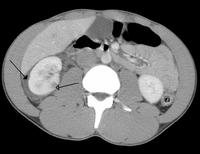
Photo from wikipedia
Physical trauma is one of the leading causes of mortality worldwide. Early post-traumatic upregulation of the pro-inflammatory immune response to traumatic injury is paralleled by an anti-inflammatory reaction. A prevalence… Click to show full abstract
Physical trauma is one of the leading causes of mortality worldwide. Early post-traumatic upregulation of the pro-inflammatory immune response to traumatic injury is paralleled by an anti-inflammatory reaction. A prevalence of each has been associated with the development of secondary complications, including nosocomial infections, acute lung injury, acute respiratory distress syndrome, sepsis and death after trauma. There is accumulating evidence that neutrophils, which are known to provide the first line of defense against invading pathogens or harmful agents, are considerably involved in the initiation and propagation of the inflammatory response to traumatic injury. In this review, we summarize and discuss recent findings about the impact of trauma and trauma-related sepsis as a secondary complication on neutrophil biology, that constitutes as the interface between homeostasis and tissue damage after a traumatic insult. Here, patient cohorts of physically injured patients with an overall injury severity score above 9 have been considered, including patients with blunt as well as penetrating injuries, and sepsis. Mechanisms were replenished by animal studies. Altered antigen presentation on neutrophils has been shown to possess biomarker features predicting both outcome and vulnerability to infectious complications in severely injured patients. Dysregulated activation of neutrophils following trauma affects their functions including phagocytizing capacity, production of reactive oxygen species, formation of neutrophil extracellular traps, which all together have been associated with the development of secondary complications. Thus, we highlight neutrophils and their functions as potential future targets for optimizing post-traumatic treatment strategies, which potentially may improve patient outcomes.
Journal Title: Shock
Year Published: 2020
Link to full text (if available)
Share on Social Media: Sign Up to like & get
recommendations!